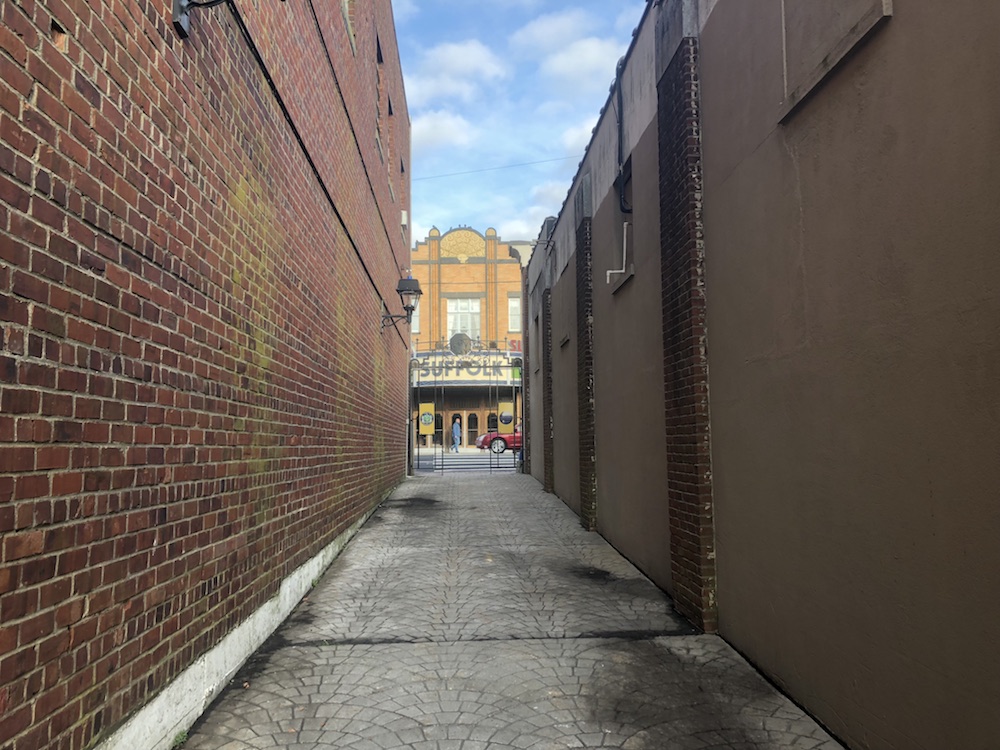Town seeks to create more pedestrian-friendly downtown

Could better lighting in alleyways downtown lead to better walkability?
As town officials consider code amendments to the DC-1 zoning district downtown, building and planning administrator Jeff Murphree proposed that revisions include enhancements to pedestrian infrastructure.
Additional signage and lighting to 10 existing alleyways on Main Street could improve walkability, safety and appearance, and foster a more visitor- and pedestrian-friendly downtown, he said at a work session Thursday.
“There needs to be better lighting so people feel safe going through them,” he said. “They need to make the journey more interesting, because you go through there right now, it’s not a hospitable environment. There’s no purpose to go there other than to go through it to get to the other side.”
Certain passageways, such as the one at 30 West Main, between Green Earth Natural Foods and Haiku and between the Riverhead Farmers Market and First Congregational Church of Riverhead are more “successful,” Mr. Murphree said, since they are wide and aesthetically pleasing with planted beds and benches.
“The artwork makes it somewhat interesting to want to go down and see it,” Mr. Murphree said of the walkway near the First Congregational Church of Riverhead.
Others, such as the former Sneaker Aquarium and in between Subway and the Riverhead Coin Shoppe, are not well-lit, landscaped or unclear in terms of who can use them, he said.
Despite being privately owned, many of the alleyways provide a public use, such as the alleyway between the Vail-Leavitt Music Hall and Summerwind Square.
“If it had some signage, that’d be a really big help for people who are not familiar with the area,” Mr. Murphree said.
Providing lighting in alleyways between vacant buildings without electricity could be challenging, Councilwoman Jodi Giglio said.
“I don’t know how to address that other than with separate lamp posts that the town owns,” she said.
Councilwoman Catherine Kent suggested string lighting that could be connected to a town fixture be used to illuminate dark alleyways.
Supervisor Laura Jens-Smith acknowledged that there is “confusion” over light maintenance in the alleys. “It’s a mixed bag of who maintains the lights there,” she said.
Ms. Jens-Smith also said the town has received a grant for municipal wayfaring signs and has plans to implement more lighting downtown.
A clear pathway leading to the Riverfront is also needed, Mr. Murphree said. “You’re walking through a parking lot,” he said. Town members agreed that the space surrounding the East End Arts Council could provide that access.
Councilman James Wooten said the current walkway feels private because of the gates. Mr. Murphree agreed.
“If people don’t know what the intent of it is, they’re less likely to use it,” he said.
Board members agreed that to truly revitalize downtown, there something needs to be done about the vacant buildings, some of which cannot be rented.
The supervisor said code enforcement officers and the fire marshal recently inspected some of the buildings. “We expect these landlords to bring the buildings into compliance,” she said.
“We need a bulldozer to take a couple of them down and make that village green,” Councilman Tim Hubbard said. “Downtown would thrive.”
Under the proposed DC-1 code amendments, officials may also prohibit five-story buildings on the south side of Main Street.
“That river belongs to Riverhead,” Mr. Wooten said. “You’re gonna throw a lot more value on the north side of Main Street if you create open vistas to the river on the south side.”
Officials are hopeful that a new opportunity zone tax incentive could attract investors to the downtown area.
But Ms. Giglio said that the building height restrictions could deter some developers.
Ms. Kent argued that taller buildings should be placed outside the DC-1 district. “I’m not interested in having a couple of developers tell the rest of our town what we’re going to do with it,” she said.
Mr. Murphree, who plans to present the pedestrian improvements to the Landmarks Preservation Commission and Architectural Review Board next week, indicated that the code will continued to be revised before a public hearing is set. “We’ve got a lot to think about,” he said.
Photo caption: One idea is to improve lighting in down alleyways. (Tara Smith photo)









